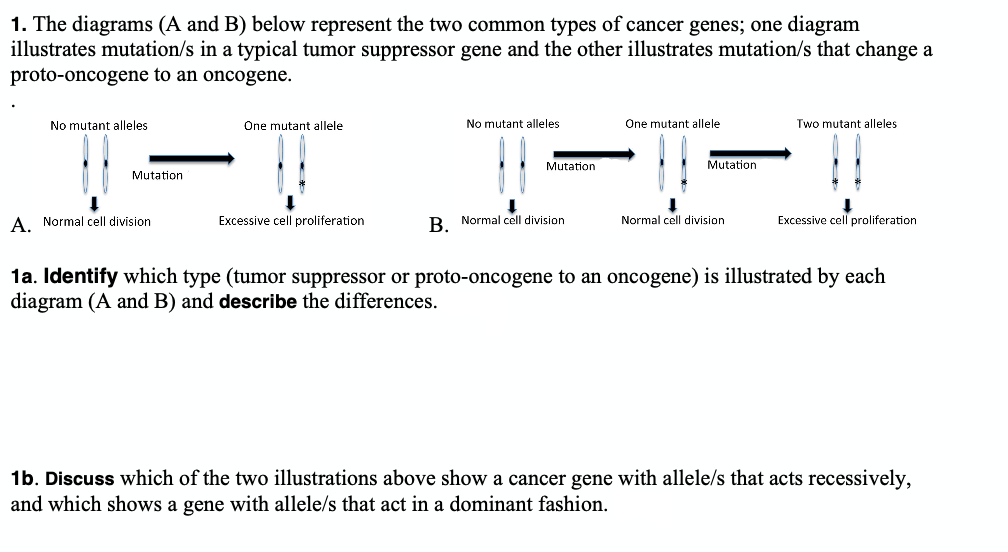1. The diagrams (A and B) below represent the two common types of cancer genes; one diagram illustrates mutation/s in a typical tumor suppressor gene and the other illustrates mutation/s that change a proto-oncogene to an oncogene. No mutant alleles One mutant allele No mutant alleles One mutant allele Two mutant alleles Mutation Mutation Mutation A Normal cell division Excessive cell proliferation B Normal cell division Normal cell division Excessive cell proliferation 1a. Identify which type (tumor suppressor or proto-oncogene to an oncogene) is illustrated by each diagram (A and B) and describe the differences. 1b. Discuss which of the two illustrations above show a cancer gene with allele/s that acts recessively, and which shows a gene with allele/s that act in a dominant fashion.
1. The diagrams (A and B) below represent the two common types of cancer genes; one diagram illustrates mutation/s in a typical tumor suppressor gene and the other illustrates mutation/s that change a proto-oncogene to an oncogene. No mutant alleles One mutant allele No mutant alleles One mutant allele Two mutant alleles Mutation Mutation Mutation A Normal cell division Excessive cell proliferation B Normal cell division Normal cell division Excessive cell proliferation 1a. Identify which type (tumor suppressor or proto-oncogene to an oncogene) is illustrated by each diagram (A and B) and describe the differences. 1b. Discuss which of the two illustrations above show a cancer gene with allele/s that acts recessively, and which shows a gene with allele/s that act in a dominant fashion.
Human Heredity: Principles and Issues (MindTap Course List)
11th Edition
ISBN:9781305251052
Author:Michael Cummings
Publisher:Michael Cummings
Chapter12: Genes And Cancer
Section: Chapter Questions
Problem 15QP: Which of the following mutations will result in cancer? a. homozygous recessive mutation in a...
Related questions
Question
100%
please help?

Transcribed Image Text:1. The diagrams (A and B) below represent the two common types of cancer genes; one diagram
illustrates mutation/s in a typical tumor suppressor gene and the other illustrates mutation/s that change a
proto-oncogene to an oncogene.
No mutant alleles
One mutant allele
No mutant alleles
One mutant allele
Two mutant alleles
Mutation
Mutation
Mutation
A Normal cell division
Excessive cell proliferation
B Normal cell division
Normal cell division
Excessive cell proliferation
1a. Identify which type (tumor suppressor or proto-oncogene to an oncogene) is illustrated by each
diagram (A and B) and describe the differences.
1b. Discuss which of the two illustrations above show a cancer gene with allele/s that acts recessively,
and which shows a gene with allele/s that act in a dominant fashion.
Expert Solution
This question has been solved!
Explore an expertly crafted, step-by-step solution for a thorough understanding of key concepts.
This is a popular solution!
Trending now
This is a popular solution!
Step by step
Solved in 2 steps

Knowledge Booster
Learn more about
Need a deep-dive on the concept behind this application? Look no further. Learn more about this topic, biology and related others by exploring similar questions and additional content below.Recommended textbooks for you

Human Heredity: Principles and Issues (MindTap Co…
Biology
ISBN:
9781305251052
Author:
Michael Cummings
Publisher:
Cengage Learning

Biology (MindTap Course List)
Biology
ISBN:
9781337392938
Author:
Eldra Solomon, Charles Martin, Diana W. Martin, Linda R. Berg
Publisher:
Cengage Learning

Biology: The Dynamic Science (MindTap Course List)
Biology
ISBN:
9781305389892
Author:
Peter J. Russell, Paul E. Hertz, Beverly McMillan
Publisher:
Cengage Learning

Human Heredity: Principles and Issues (MindTap Co…
Biology
ISBN:
9781305251052
Author:
Michael Cummings
Publisher:
Cengage Learning

Biology (MindTap Course List)
Biology
ISBN:
9781337392938
Author:
Eldra Solomon, Charles Martin, Diana W. Martin, Linda R. Berg
Publisher:
Cengage Learning

Biology: The Dynamic Science (MindTap Course List)
Biology
ISBN:
9781305389892
Author:
Peter J. Russell, Paul E. Hertz, Beverly McMillan
Publisher:
Cengage Learning

Biology 2e
Biology
ISBN:
9781947172517
Author:
Matthew Douglas, Jung Choi, Mary Ann Clark
Publisher:
OpenStax

Biology: The Unity and Diversity of Life (MindTap…
Biology
ISBN:
9781337408332
Author:
Cecie Starr, Ralph Taggart, Christine Evers, Lisa Starr
Publisher:
Cengage Learning